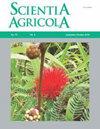Soybean genotypes selection with resistance to White Mold and agronomic performance from moderately resistant parents
IF 2.6
3区 农林科学
Q1 Agricultural and Biological Sciences
引用次数: 0
Abstract
White Mold (WM) is a yield–limiting disease found in soybean. However, up to now no cultivars have been genetically resistant to this disease. Given this context, the present study aimed to develop superior soybean lines with resistance to WM, while maintaining other desirable agronomic traits. Two early maturing soybean cultivars (i.e., EMGOPA 316 and MG/BR 46– Conquista), moderately resistant to WM were used for biparental crosses from which the analyzed population was derived. Therefore, we assessed the resistance to WM in early generation testing of this population. Additionally, we determined the agronomic traits, genetic parameters and selection gains. From 348 F2 genotypes, 35 transgressive genotypes moderately resistant to WM were identified, amongst which 22 genotypes showed desirable agronomic traits for early cycle and grain yield. Moreover, 69 lines were selected as the most promising genotypes for each agronomic trait (i.e. based on the number of days to flowering and maturity, plant height at flowering and maturity, number of nodes on main stem at flowering and maturity, number of pods, grain yield, etc.). Among these selected lines, ten progenies emerged as the superior genotypes for grain yield and early cycle. All together, these results demonstrated that the cross between EMGOPA 316 × MG/BR 46 (Conquista) revealed promising progenies with moderate resistance to WM and/or desirable agronomic traits. Thus, these lines could be used as future resources for breeding efforts aimed at improving resistance to WM.大豆抗白霉病基因型选择及中等抗性亲本的农艺性能
白霉病是大豆的一种产量限制病害。然而,到目前为止,还没有对这种疾病具有遗传抗性的品种。在此背景下,本研究旨在培育抗WM的优良大豆品系,同时保持其他理想的农艺性状。采用EMGOPA 316和MG/BR 46 - Conquista这两个对WM具有中等抗性的早熟大豆品种进行双亲本杂交,获得了分析群体。因此,我们在该种群的早期代试验中评估了对WM的抗性。此外,我们确定了农艺性状、遗传参数和选择增益。从348个F2基因型中,鉴定出35个对WM具有中等抗性的侵染基因型,其中22个基因型表现出较好的早期周期和产量农艺性状。此外,在每个农艺性状(即花期和成熟期天数、花期和成熟期株高、花期和成熟期主茎节数、荚果数、籽粒产量等)上,选择了69个最有希望的基因型。在这些选系中,有10个子代在产量和早周期方面表现出优越的基因型。综上所述,EMGOPA 316 × MG/BR 46 (Conquista)杂交后代具有中等抗WM和/或理想的农艺性状。因此,这些品系可以作为未来育种工作的资源,旨在提高对WM的抗性。
本文章由计算机程序翻译,如有差异,请以英文原文为准。
求助全文
约1分钟内获得全文
求助全文
来源期刊

Scientia Agricola
农林科学-农业综合
CiteScore
5.10
自引率
3.80%
发文量
78
审稿时长
18-36 weeks
期刊介绍:
Scientia Agricola is a journal of the University of São Paulo edited at the Luiz de Queiroz campus in Piracicaba, a city in São Paulo state, southeastern Brazil. Scientia Agricola publishes original articles which contribute to the advancement of the agricultural, environmental and biological sciences.
 求助内容:
求助内容: 应助结果提醒方式:
应助结果提醒方式:


